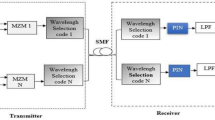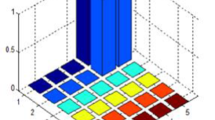Abstract
Phase induced intensity noise (PIIN) and multiple access interference (MAI) are the main parameters that affect the performance of optical code division multiple access (OCDMA) systems, leading to degradations in system performance and reduction in the number of active users. So, this paper presents an efficient modified multi-service (MMS) code that can be used for encoding the spectral amplitude of the optical source in OCDMA systems to avoid these limitations. The proposed code disposes the effect of MAI, PIIN, and gives better performance than the other traditional codes. It can support a large number of active users (80 at bit error rate of 10−9) with a small code weight (w = 4). Also, it achieves a practical code length with a simple receiver structure.















Similar content being viewed by others
References
Anuar, M. S., Alijunid, S. A., Saad, N. M., & Hamzah, S. M. (2009). New design of spectral amplitude coding in OCDMA with zero cross-correlation. Optics Communications, 282(14), 2659–2664.
Wei, Z., Shalaby, H. M. H., & Ghafouri-Shiraz, H. (2001). Modified quadratic congruence codes for Fiber Bragg-grating-based spectral-amplitude-coding optical CDMA systems. Journal of Lightwave Technology, 19(9), 1274–1281.
Hasoon, F. N., Aljunid, S. A., Samad, M. D. A., Abdullah, M. K., & Shaari, S. (2008). Spectral amplitude coding OCDMA using AND subtraction technique. Applied Optics, 47(9), 1263–1268.
Ahmed, N., Aljunid, S. A., Fadil, A., Ahmed, R. B., & Rashid, M. A. (2013). Performance enhancement of OCDMA system using NAND detection with modified double weight (MDW) code for optical access network. Optik—International Journal for Light and Electron Optics, 124(13), 1402–1407.
Ahmed, H. Y., & Nisar, K. S. (2013). Diagonal eigenvalue unity (DEU) code for spectral amplitude coding-optical code division multiple access. Optical Fiber Technology, 19(4), 335–347.
Eltaif, T., Shalaby, H. M., Shaari, S., & Hamarsheh, M. N. (2009). Performance analysis of a hybrid fiber Bragg grating-based spectral-amplitude-coding/successive interference cancellation for optical CDMA systems. Optics Communications, 282(1), 1–6.
Goursaud, C., Julien-Vergonjanne, A., Aupetit-Berthelemot, C., Cances, J. P., & Dumas, J. M. (2005). Study of parallel interference cancellation structures for incoherent DS-OCDMA systems. In Asia-Pacific conference on communications, Perth, Western Australia, 2005.
Abdullah, M. K., Hasoon, F. N., Aljunid, S. A., & Shaari, S. (2008). Performance of OCDMA systems with new spectral direct detection (SDD) technique using enhanced double weight (EDW) code. Optics Communications, 281(18), 4658–4662.
Norazimah, M. Z., Aljunid, S. A., Fadhil, H. A., & Md Zain, A. S. (2011). Analytical comparison of various SAC–OCDMA detection techniques. In Photonics (ICP), 2011 IEEE 2nd international conference on, Kata Kinabalu, 2011.
Salehi, J. A. (1989). Code division multiple-access techniques in optical fiber networks-part I: Fundamental principles. IEEE Transactions on Communications, 37(8), 824–833.
Wei, Z. (2002). Unipolar codes with ideal in-phase cross-correlation for spectral amplitude-coding optical CDMA systems. IEEE Transactions on Communications, 50, 1209–1212.
Smith, E. D., Blaikie, R. J., & Taylor, D. P. (1998). Performance enhancement of spectral-amplitude-coding optical CDMA using pulse-position modulation. IEEE Transactions on Communications, 46(9), 1176–1185.
Kakaee, M. H., Seyedzadeh, S., Fadhil, H. A., Ahmed Anas, S. B., & Mokhtar, M. (2014). Development of multi-service (MS) for SAC–OCDMA systems. Optics & Laser Technology, 60(8), 49–55.
Malleswari, M., & Murugesan, K. (2013). Construction and bit error analysis of zero cross-correlation codes for SAC-Optical CDMA systems. Journal of Optics, 42(4), 307–310.
Ahmed Anas, S. B., Abdullah, M. K., Mokhtar, M., Aljunid, S. A., & Walker, S. D. (2009). Optical domain service differentiation using spectral-amplitude-coding. Optical Fiber Technology, 15(1), 26–32.
Aljunid, S. A., Ismail, M., Ramli, A. R., Ali, B. M., & Abdullah, M. K. (2004). A new family of optical code sequences for spectral-amplitude-coding optical CDMA systems. IEEE Photonics Technology Letters, 16(10), 2383–2385.
Author information
Authors and Affiliations
Corresponding author
Rights and permissions
About this article
Cite this article
Mostafa, S., Mohamed, A.EN.A., El-Samie, F.E.A. et al. Eradication of Multiple Access Interference Using a Modified Multi-service Code for SAC–OCDMA. Wireless Pers Commun 83, 855–872 (2015). https://doi.org/10.1007/s11277-015-2430-2
Published:
Issue Date:
DOI: https://doi.org/10.1007/s11277-015-2430-2




